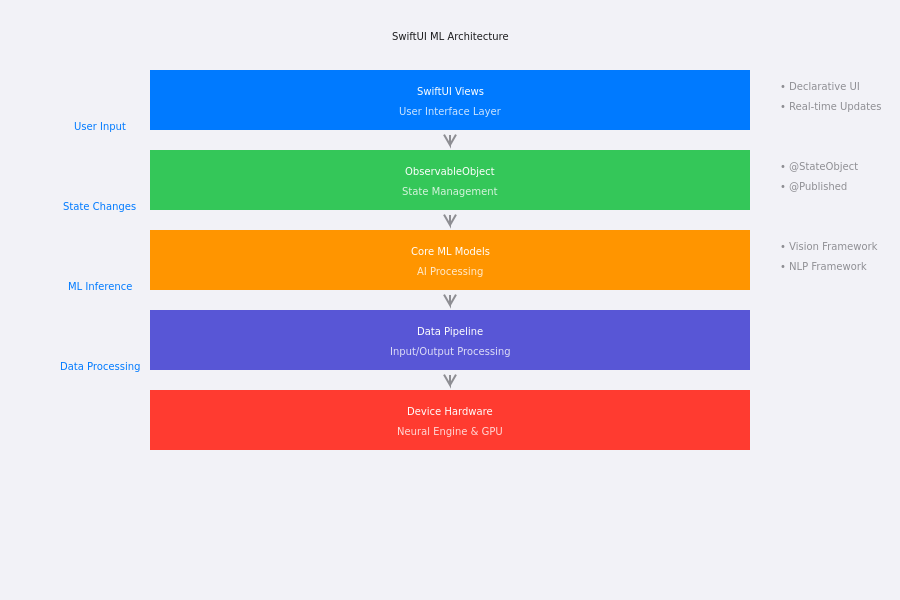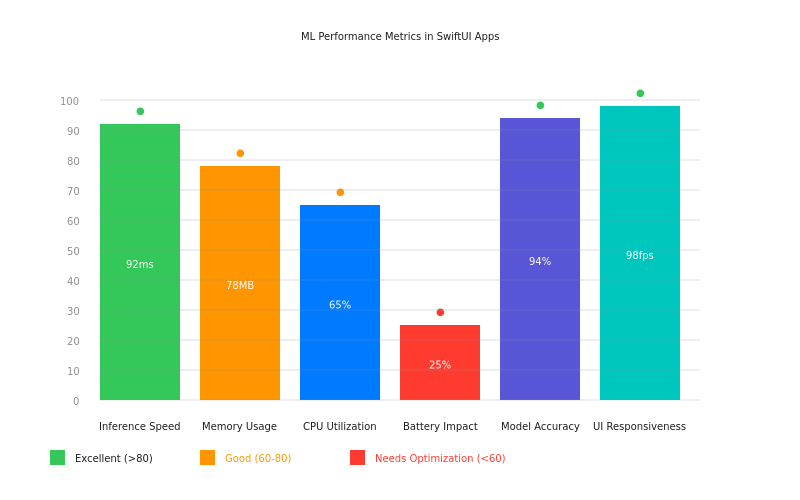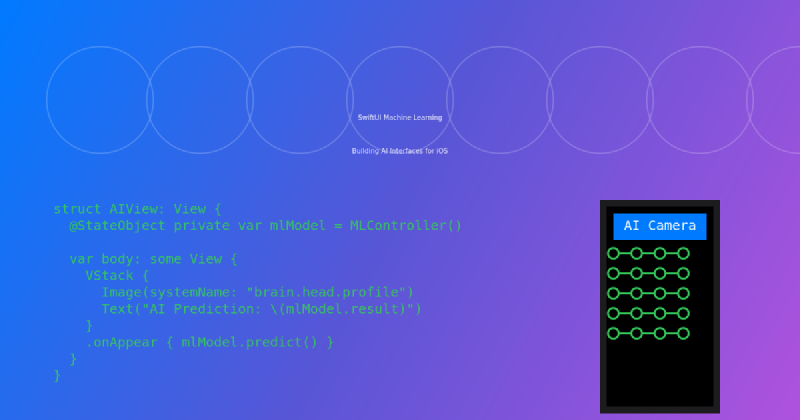The convergence of SwiftUI and machine learning represents one of the most exciting frontiers in iOS development, offering developers unprecedented opportunities to create intelligent, responsive applications that seamlessly integrate artificial intelligence into native user experiences. This powerful combination enables the creation of sophisticated interfaces that can adapt, learn, and respond to user behavior while maintaining the smooth, intuitive feel that iOS users expect from premium mobile applications.
Discover the latest trends in AI development to stay current with cutting-edge techniques that are transforming mobile application development. The marriage of SwiftUI’s declarative interface framework with Apple’s robust machine learning ecosystem creates possibilities for developing applications that were previously impossible or prohibitively complex to implement on mobile platforms.
The SwiftUI and Core ML Ecosystem
Apple’s ecosystem for machine learning integration provides developers with a comprehensive toolkit that spans from model creation and optimization to seamless deployment within SwiftUI applications. Core ML serves as the foundational framework that enables efficient on-device inference, while SwiftUI provides the declarative interface layer that can dynamically respond to model predictions and user interactions. This combination creates a powerful development environment where machine learning capabilities can be deeply integrated into the user experience rather than treated as isolated features.
The architectural advantages of this approach extend beyond simple functionality integration. SwiftUI’s reactive programming model naturally complements the asynchronous nature of machine learning inference, allowing interfaces to update smoothly as models process data and generate predictions. This synergy results in applications that feel responsive and intelligent while maintaining optimal performance characteristics that are essential for mobile deployment.
Building Intelligent User Interfaces
The process of creating AI-powered interfaces in SwiftUI requires careful consideration of both the machine learning pipeline and the user experience design principles that make iOS applications successful. Unlike traditional interfaces that rely solely on user input to determine behavior, AI-enhanced SwiftUI applications must balance automated intelligence with user control, creating experiences that feel both magical and predictable.
Successful implementation of machine learning in SwiftUI interfaces often involves creating adaptive layouts that can respond to model confidence levels, prediction categories, and real-time analysis results. This might include dynamic content arrangement based on user preferences learned through behavioral analysis, automatic interface customization based on usage patterns, or real-time visual feedback that helps users understand how the AI is interpreting their actions and inputs.
Enhance your development workflow with Claude, an AI assistant that can help you architect complex SwiftUI applications and optimize machine learning integration strategies. The complexity of modern AI-powered mobile applications benefits significantly from intelligent development assistance that can provide architectural guidance and implementation best practices.
Core ML Integration Strategies
Integrating Core ML models into SwiftUI applications requires understanding both the technical requirements of model deployment and the design patterns that create seamless user experiences. The most effective approaches involve creating abstraction layers that separate model management from interface logic, enabling clean separation of concerns while maintaining efficient data flow between machine learning components and user interface elements.
Model loading and initialization strategies play a crucial role in application performance and user experience. SwiftUI applications benefit from lazy loading approaches that can defer model initialization until needed while providing appropriate loading states and fallback behaviors when models are unavailable or experiencing processing delays. This approach ensures that applications remain responsive even when dealing with complex models that require significant computational resources.
The integration process also involves careful consideration of data preprocessing and postprocessing workflows that transform user input into model-compatible formats and convert model outputs into meaningful interface updates. SwiftUI’s property wrapper system provides elegant mechanisms for managing these data transformations while maintaining clean, readable code that can be easily maintained and extended as application requirements evolve.
Real-Time Inference and Interface Updates
One of the most compelling aspects of SwiftUI machine learning applications is their ability to provide real-time feedback based on continuous model inference. This capability enables the creation of interfaces that can adapt instantly to changing conditions, user behavior, or environmental factors detected through device sensors. The challenge lies in balancing computational efficiency with interface responsiveness while ensuring that model predictions enhance rather than interfere with the user experience.
Effective real-time inference implementations often employ strategic batching, prediction caching, and intelligent update scheduling that minimize computational overhead while maximizing interface responsiveness. SwiftUI’s declarative nature makes it particularly well-suited for these applications because interface updates can be tied directly to model output states, creating natural reactive behaviors that feel intuitive to users.
The architectural patterns that support real-time inference typically involve creating observable model managers that encapsulate prediction logic while exposing clean interfaces that SwiftUI views can observe and react to. This separation enables efficient testing, debugging, and optimization of machine learning components without compromising interface development workflows.
Computer Vision Applications
Computer vision represents one of the most mature and accessible areas for SwiftUI machine learning integration, with Apple’s Vision framework providing robust capabilities for image analysis, object detection, and scene understanding. SwiftUI applications can leverage these capabilities to create interfaces that respond intelligently to camera input, photo analysis, and real-world object recognition.
The development of computer vision interfaces often involves creating custom camera views that can overlay prediction results in real-time, providing users with augmented reality experiences that blend digital information with physical environments. These implementations require careful coordination between camera capture, image processing, model inference, and interface updates to maintain smooth frame rates and responsive interactions.
Advanced computer vision applications might include document scanning interfaces that can automatically detect and correct document boundaries, photo organization systems that can categorize and tag images based on content analysis, or accessibility features that can describe visual content to users with visual impairments. Each of these applications demonstrates how machine learning can enhance rather than replace traditional interface paradigms.
Natural Language Processing Integration
Natural language processing capabilities in SwiftUI applications open possibilities for creating interfaces that can understand, generate, and respond to human language in sophisticated ways. Apple’s Natural Language framework provides comprehensive tools for text analysis, language detection, sentiment analysis, and entity recognition that can be seamlessly integrated into SwiftUI applications.
The implementation of NLP features often involves creating intelligent text input systems that can provide real-time suggestions, automatic corrections, or contextual assistance based on content analysis. These systems might include smart reply suggestions in messaging applications, automatic content categorization in note-taking apps, or intelligent search interfaces that can understand user intent beyond literal keyword matching.
More advanced NLP implementations might include voice-to-text systems with contextual understanding, automatic content summarization features, or multilingual interfaces that can adapt their behavior based on detected user language preferences. The key to successful NLP integration lies in creating interfaces that feel natural and helpful rather than intrusive or overly complex.

The architectural foundation of SwiftUI machine learning applications requires careful orchestration of multiple components including model management, data processing, interface updates, and error handling. This systematic approach ensures maintainable, performant applications that can scale effectively as requirements evolve.
Performance Optimization and Model Efficiency
Performance optimization in SwiftUI machine learning applications requires understanding the computational characteristics of different model types and implementing strategies that maximize efficiency while maintaining excellent user experiences. This involves both technical optimizations at the model level and architectural decisions that minimize unnecessary computational overhead in interface updates and data processing workflows.
Model quantization and optimization techniques can significantly reduce memory usage and inference time while maintaining acceptable prediction accuracy. SwiftUI applications particularly benefit from these optimizations because mobile devices have limited computational resources and users expect immediate responsiveness from interface interactions. The challenge involves finding the optimal balance between model capability and performance characteristics for specific use cases.
Caching strategies play a crucial role in performance optimization, enabling applications to avoid redundant calculations while providing instant access to frequently requested predictions. Intelligent caching implementations might include prediction result caching for repeated inputs, intermediate computation caching for complex processing pipelines, or strategic precomputation of likely-needed results based on user behavior patterns.
Privacy and On-Device Processing
Privacy considerations are paramount in machine learning applications, and SwiftUI development benefits significantly from Apple’s emphasis on on-device processing capabilities that protect user data while enabling sophisticated AI features. This approach ensures that sensitive user information never leaves the device while still providing access to powerful machine learning capabilities that can enhance application functionality.
On-device processing strategies require careful consideration of model size, computational requirements, and energy efficiency to ensure that privacy benefits don’t come at the cost of user experience. SwiftUI applications can implement progressive disclosure patterns that allow users to control how much data processing occurs locally versus remotely, providing transparency and control over privacy trade-offs.
The implementation of privacy-focused machine learning often involves creating secure data processing pipelines that can analyze user behavior and preferences without storing or transmitting identifiable information. These systems might include differential privacy techniques, federated learning approaches, or local model personalization that adapts to individual users without compromising privacy.
Explore advanced AI research capabilities with Perplexity to stay informed about emerging privacy-preserving machine learning techniques that can enhance your SwiftUI applications while protecting user data. The intersection of privacy and artificial intelligence continues to evolve rapidly, offering new opportunities for creating responsible AI applications.
Advanced Model Integration Patterns
Advanced SwiftUI machine learning applications often employ sophisticated integration patterns that enable complex AI behaviors while maintaining clean, maintainable codebases. These patterns might include multi-model ensembles that combine predictions from multiple specialized models, hierarchical model architectures that process data at different levels of abstraction, or adaptive model selection systems that choose optimal models based on current conditions.
Pipeline architectures represent another advanced pattern where multiple processing stages can be chained together to create complex analysis workflows. These might include preprocessing stages that clean and normalize data, multiple inference stages that extract different types of information, and postprocessing stages that combine results into actionable interface updates. SwiftUI’s reactive programming model naturally supports these pipeline architectures through its property wrapper and observation systems.
Dynamic model loading represents an advanced technique that allows applications to adapt their AI capabilities based on user needs, device capabilities, or network conditions. This approach might involve downloading specialized models for specific tasks, updating models based on new training data, or selecting different model variants based on performance requirements and available computational resources.
Testing and Debugging ML Interfaces
Testing machine learning integrated SwiftUI applications requires specialized approaches that account for the non-deterministic nature of AI systems while ensuring reliable interface behaviors. This involves creating test frameworks that can validate model integration, interface responsiveness, and error handling under various conditions including model failures, unexpected inputs, and edge cases that might not occur during normal operation.
Mock model implementations provide valuable tools for interface testing by enabling deterministic behavior that can be reliably tested while isolating interface logic from model complexity. These implementations allow developers to validate interface behaviors across a full range of possible model outputs without requiring complex test data or lengthy model inference processes.
Performance testing for machine learning applications involves monitoring computational overhead, memory usage, and interface responsiveness under realistic usage conditions. This might include stress testing with rapid user interactions, endurance testing with extended inference sessions, or resource monitoring during complex multi-model processing scenarios.

Understanding and optimizing key performance metrics ensures that SwiftUI machine learning applications deliver exceptional user experiences while making efficient use of device resources. Regular monitoring of these metrics throughout development helps identify optimization opportunities and potential performance issues.
Deployment and App Store Considerations
Deploying SwiftUI machine learning applications requires careful attention to App Store guidelines, model packaging strategies, and user communication about AI features. Apple’s App Store policies regarding machine learning applications emphasize user privacy, transparent AI usage, and appropriate content handling that developers must consider throughout the development process.
Model packaging and distribution strategies affect both application size and update flexibility. Applications might embed models directly for immediate availability, download models on demand to reduce initial installation size, or use hybrid approaches that balance availability with resource efficiency. Each approach has implications for user experience, network usage, and maintenance complexity that must be evaluated against specific application requirements.
User communication about AI features plays a crucial role in application success and App Store approval. Users should understand how AI enhances their experience, what data is processed, and how they can control AI-driven behaviors. SwiftUI applications can implement progressive onboarding flows that educate users about AI features while respecting their privacy preferences and usage comfort levels.
Future Directions and Emerging Technologies
The future of SwiftUI machine learning development promises exciting advances in areas such as federated learning, edge AI optimization, and cross-platform model sharing that will expand possibilities for intelligent iOS applications. Emerging technologies like neural architecture search and automated model optimization will simplify the process of creating efficient models specifically optimized for mobile deployment scenarios.
Integration with emerging Apple technologies such as RealityKit for augmented reality applications, HealthKit for health-focused AI features, or HomeKit for intelligent home automation represents exciting frontiers where SwiftUI machine learning applications can create novel user experiences that were previously impossible to implement effectively on mobile platforms.
The continued evolution of Swift language features and SwiftUI capabilities will likely introduce new patterns and frameworks specifically designed to support machine learning integration, making it easier for developers to create sophisticated AI-powered applications while maintaining the clean, declarative code style that makes SwiftUI development so appealing.
The democratization of machine learning development through improved tools, frameworks, and educational resources means that SwiftUI developers can increasingly focus on creating exceptional user experiences rather than wrestling with complex AI implementation details. This trend will likely accelerate the adoption of machine learning features in iOS applications while maintaining the high standards of user experience that define successful mobile applications.
Disclaimer
This article is for informational purposes only and does not constitute professional advice. The views expressed are based on current understanding of SwiftUI and machine learning technologies as they apply to iOS development. Readers should conduct their own research and consider their specific requirements when implementing machine learning features in iOS applications. The effectiveness and appropriateness of AI integration may vary depending on specific use cases, target audiences, and technical constraints. Always follow Apple’s guidelines and best practices when developing and deploying machine learning applications on the App Store.
